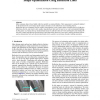Free Online Productivity Tools
i2Speak
i2Symbol
i2OCR
iTex2Img
iWeb2Print
iWeb2Shot
i2Type
iPdf2Split
iPdf2Merge
i2Bopomofo
i2Arabic
i2Style
i2Image
i2PDF
iLatex2Rtf
Sci2ools
SGP
2007
2007
Shape optimization using reflection lines
Many common objects have highly reflective metallic or painted finishes. Their appearance is primarily defined by the distortion the curved shape of the surface introduces in the reflections of surrounding objects. Reflection lines are commonly used for surface interrogation, as they capture many essential aspects of reflection distortion directly, and clearly show surface imperfections that may be hard to see with conventional lighting. In this paper, we propose the use of functionals based on reflection lines for mesh optimization and editing. We describe a simple and efficient discretization of such functionals based on screen-space surface parameterization, and we demonstrate how such discrete functionals can be used for several types of surface editing operations.
Computer Graphics | Many Common Objects | Reflection Lines | Screen-space Surface Parameterization | SGP 2007 |
| Added | 30 Sep 2010 |
| Updated | 30 Sep 2010 |
| Type | Conference |
| Year | 2007 |
| Where | SGP |
| Authors | E. Tosun, Yotam I. Gingold, Jason Reisman, Denis Zorin |
Comments (0)

